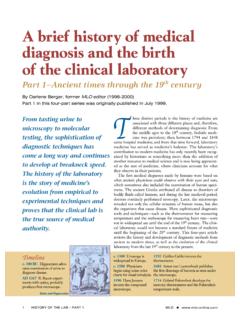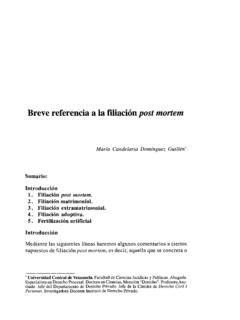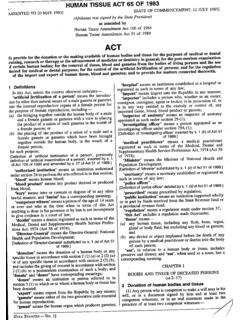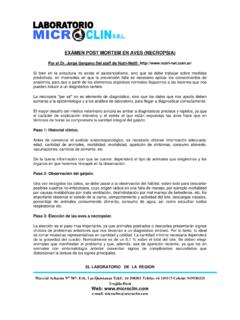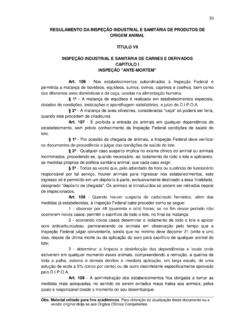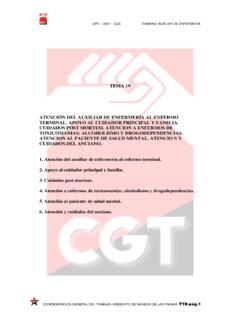Transcription of Early post-mortem changes and stages of …
1 Exp Appl Acarol (2009) 49:21 36. DOI Early post- mortem changes and stages of decomposition in exposed cadavers M. Lee Goff Received: 1 June 2009 / Accepted: 4 June 2009 / Published online: 25 June 2009. Springer Science+Business Media 2009. Abstract decomposition of an exposed cadaver is a continuous process, beginning at the moment of death and ending when the body is reduced to a dried skeleton. Traditional estimates of the period of time since death or post- mortem interval have been based on a series of grossly observable changes to the body, including livor mortis, algor mortis, rigor mortis and similar phenomena. These changes will be described briefly and their relative significance discussed. More recently, insects, mites and other arthropods have been increasingly used by law enforcement to provide an estimate of the post- mortem interval.
2 Although the process of decomposition is continuous, it is useful to divide this into a series of five stages : Fresh, Bloated, Decay, Postdecay and Skeletal. Here these stages are characterized by physical parameters and related assemblages of arthropods, to provide a framework for consideration of the decomposition process and acarine relationships to the body. Keywords decomposition Forensic Acari Post- mortem changes . Succession Introduction There are typically two known points at the beginning of the task of estimating a period of time since death: the last time the individual was reliably known to be alive and the time at which the body was discovered. The death occurred between these two points and the aim is to estimate when it most probably took place.
3 Keep in mind that this will be an estimate, since it is generally accepted that there is actually no scientific way to precisely determine the exact period of time since death. What is done is an estimation and in the case of entomology and acarology, an estimation of the period of arthropod activity on the body. This period of activity will reflect the minimum period of time since death or post- mortem interval (PMI), but it will not precisely determine the time of death. In most cases, the later M. Lee Goff (&). Chaminade University of Honolulu, Honolulu, HI 96816, USA. e-mail: 123. 22 Exp Appl Acarol (2009) 49:21 36. point is more accurately known than the former. Individuals tend to recall when they first encountered the dead body with considerable precision.
4 This is typically not in their normal daily routine and it makes an impression, even on those accustomed to dealing with the dead. Once the body is discovered, those processing the scene make meticulous (at least we hope meticulous) notes including times of arrival, departure, movement of the body and, finally, when the body is placed into the morgue. By contrast, the time at which the individual was last reliably known to be alive is often less precise. This is possibly due to the fact that those having the last contact most probably did not anticipate that this would be their last encounter with the individual and nothing of significance took place at the time. For this reason, the precision of the time of discovery and collection of specimens become of major significance, as they are the anchor for the estimates.
5 Estimation begins when the arthropods are collected and preserved, thus stopping the biological clock. As the process of estimating the period of insect activity takes place, it must be kept in mind that the parameters of the estimate become progressively wider as the period of time since death increases. The changes to a body that take place immediately following death are often more rapid than those occurring later during the decomposition process. The estimate begins, potentially, with a range of plus or minus minutes, goes to hours, days, weeks, months and finally its been there a long time.' The last is not the most popular with law enforcement agencies as they had already guessed that. It should also be kept in mind that the estimates presented, by their very nature, are not precise.
6 decomposition is a continuous process, beginning at the point of death and ending when the body has been reduced to a skeleton. Although this process is a continuum, virtually every study presented has divided this process into a series of stages . The number of stages has varied from one to as many as nine, depending on author and geographic region (Goff 1993) (Table 1). Although the number of stages considered has varied, there does not appear to be a firm relationship between these and the total number of species observed in each study. For example, Cornaby (1974) working in Costa Rica using lizards and toads as animal models noted only one stage for decomposition but recorded 172 species. By contrast, work in Hawaii by Early and Goff (1986), using domestic cats as the animal model, recognized five stages of decomposition but recorded 133 species.
7 Other studies have recognized other numbers but with no real correlation between stages observed and numbers of taxa reported. To a certain extent, these differences may be related to sampling methods and taxonomic interests of those involved. Early post- mortem changes As death proceeds, there are a series of Early changes to the body that result in a definite change in the physical nature and/or appearance of the body prior to the onset of gross, recognizable decompositional changes . These changes have traditionally been used in estimations of the PMI and may be a source of confusion if not recognized. For that reason, they will be briefly described here. Livor mortis (Fig. 1). One of the Early changes observable is livor mortis, also referred to as lividity, post- mortem hypostasis, vibices and suggilations.
8 This is a physical process. While the indi- vidual is alive, the heart is functioning and circulating the blood. When death occurs, circulation stops and the blood begins to settle, by gravity, to the lowest portions of the 123. Exp Appl Acarol (2009) 49:21 36 23. Table 1 Summary of selected decomposition studies giving numbers of recognized stages and taxa listed Reference Locality Animal model No. stages Total no. arthropod taxa Avila and Goff (2000) Hawaii, USA Pigs (burnt) 5 68 species Blacklith and Blacklith (1990) Ireland Birds, mice 1 27 species Bornemissza (1957) Australia Guinea pig 5 45 groups listed Braack (1986) Africa Impala 4 227 species Coe (1978) Africa Elephants 3 No totals given Cornaby (1974) Costa Rica Lizards, toads 1 172 species Davis and Goff (2000) Hawaii, USA Pigs (intertidal) 5 85 species Early and Goff (1986) Hawaii, USA Cats 5 133 species Hewadikaram and Goff Hawaii, USA Pigs 5 46 species (1991).
9 Megnin (1894) France Humans 9 No totals given Payne (1965) South Carolina, Pigs (surface) 6 522 species USA. Reed (1958) Tennessee, USA Dogs 4 240 species Rodriguez and Bass (1983) Tennessee, USA Humans 4 10 families listed Shalaby et al. (2000) Hawaii, USA Pig (hanging) 5 35 species Shean et al. (1993) Washington, USA Pig 48 species Tullis and Goff (1987) Hawaii, USA Pig 5 45 species body. This results in a discoloration of those lower, dependent parts of the body (Fig. 1). Although beginning immediately, the first signs of livor mortis are typically observed after a period of approximately 1 h following death with full development being observed 2 4 h following death (Nashelksy and McFelley 2003). At this time, the blood is still liquid and pressing on the skin will result in the blood being squeezed out of the area (blanching), only to return once pressure is removed.
10 This situation continues until 9 12 h following death, at which time the pattern will not change and the livor mortis is said to be fixed.'. Any areas of pressure resulting from clothing or continued pressure during this period will not show discoloration. Rigor mortis (Fig. 2). This is a chemical change resulting in a stiffening of the body muscles following death due to changes in the myofribrils of the muscle tissues. Immediately following death, the body becomes limp and is easily flexed. As ATP is converted to ADP and lactic acid is produced lowering the cellular pH, locking chemical bridges are formed between actin and myosin resulting in formation of rigor. Typically, the onset of rigor is first observed 2 6 h fol- lowing death and develops over the first 12 h.


